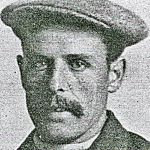Private 161321, Eastern Command, Labour Centre (E.C.L.C.)
Died 4th November 1918, aged 31
Remembered on both Blakeney War Memorials
James was born in Blakeney, 16th October 1887, the son of George Bennington and Catherine Charlotte Long nee Daniel. Both parents were born in 1857; George in Morston and Catherine in Blakeney. They married in October 1880, Blakeney, where George was a fisherman and coxswain of the Blakeney RNLI lifeboats (1896-1920). They had eight sons, with James being the fifth, and four daughters. His siblings were; George (1880), Herbert Charles (1881), William Henry (1882), Eveline (1884), Henry Matthew (1886), Frederick (1888), Ellen (1890), John (1892), Samuel Daniel (1895), Catherine Charlotte (1897-1899) and Claudia (1899). All the boys served in the war, 6 in the armed services, one in the Merchant Navy and one on the Home Front while Claudia was a nurse.
The 1911 Census records his father at No. 80 High Street, Blakeney with his second wife Fanny as well as three children. Meanwhile James, aged 22, was living with his uncle and aunt, James and Phoebe Lee, on Mariners Hill and described as a fisherman working on his own account. The following year, 19th April 1912, James enlisted with the Norfolk Regiment at Wells giving his age as 22 years 10 months when he was actually 2 years older. His medical at Fakenham noted that his physical condition was good, but slightly deaf; a condition that was to blight his military service.
He trained during 1912 and 1913 with his regiment then the 2nd/5th Battalion (Private 1673) when called up at the outbreak of war. His unit assembled at East Dereham and to begin with had neither guns nor equipment let alone any uniform. By December they were camped at Peterborough where they were issued with Japanese rifles. 1915 began with a recruitment march through Norfolk followed by a return to Peterborough for more training then on to Cambridge where James agreed to serve overseas. This was never to happen and he moved on with his unit to Bury St Edmunds, Thetford and Brentwood, where they dug trenches before returning to Bury St Edmunds for the winter of 1915/16.
1916 was a downward spiral for James as he was moved with other low category men of the 2nd/5th Bn. first to the 61st Provisional Bn., then to the 11th Bn. Finally he was transferred from military to civilian service beginning with the Norfolk County Agriculture Company in March 1917 followed by the 428th Agricultural Company of the newly formed Labour Corps in May. This Company was under the command of the Eastern Command Labour Centre and James, still a Private, was assigned a new number, 161321.
Within the year his case was before a Medical Board where his suffering from a disability made either reclassification or discharge probable. The evidence provided showed that James had “suffered from ear damage [for] as long as he could remember. Thinks it was due to a cart wheel going over his head.” His ear injuries and continuing inflammation of the middle ear were considered to be both attributable and aggravated by military service and in April 1918, he was reclassified and transferred to the Army Reserve, Class W. He was then placed with the Chemical Manure Works at King’s, Lynn. Although now out of Military control, the army retained the right to call him up if necessary and his work contributed towards his army pension.
James died at the West Norfolk and Lynn Hospital of pneumonia and influenza in November, a casualty of the Spanish flue. He is not commemorated by the CWGC.

